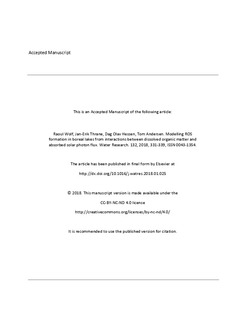| dc.description.abstract | Concentrations of dissolved organic matter (DOM) are increasing in a large number of lakes across the Northern hemisphere. This browning serves a dual role for biota by protecting against harmful ultraviolet radiation, while also absorbing photosynthetically active radiation. The photochemical activation of DOM and subsequent formation of reactive oxygen species (ROS) is a potentially harmful side effect, but can be difficult to measure directly in situ. In this study, we combine a data set of physico-chemical properties from 71 Nordic lakes with in vitro ROS formation quantum yields to predict ROS formations across a representative boreal ecosystem gradient. For the upper centimeter of the water column, we calculate ROS formations in the range of 7.93–12.56 μmol L−1 h−1. In the first meter, they range between 1.69 and 6.69 μmol L−1 h−1 and in the remaining depth the range is 0.01–0.46 μmol L−1 h−1. These ROS formations are comparable with previously field-measured hydrogen peroxide formation rates and likely affect both phyto- and zooplankton, as well as lake chemistry. Interestingly, wavelengths of the visible spectrum (>400 nm) contribute more than half of the overall ROS formation in surface-near water layers. The association between DOM and ROS formation was found to be two-fold. While DOM promotes ROS formation in the first centimeters of the water column, the shading effect of light attenuation overpowers this with increasing depth. In the context of water browning, our results indicate the emergence of an underestimated oxidative stress environment for lake biota in the upper centimeters of the water column. | nb_NO |
